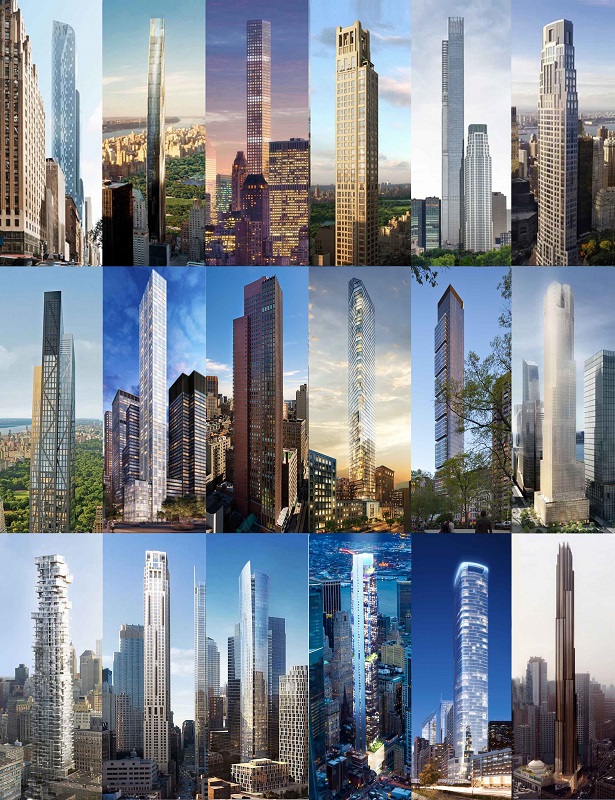Storeys of a building
The British English word ‘storey’ (plural storeys) and the American English ‘story’ (plural stories) refer to a level element of a building that has a useable floor. The term may be used interchangeably with ‘floor’, ‘level’, or ‘deck’; however, it is usual for a building to be described as a ’ten-storey building’ while the individual storey may be referred to as the ‘tenth floor’.
‘Storey’ tends to exclude building levels that are not covered by a roof, such as a roof terrace. It is also not used to refer to the street level floor which is typically called the ‘ground floor’.
Most houses are two-storeys, while bungalows are single-storey. A multi-storey building is a building that has multiple storeys, and typically contains vertical circulation in the form of ramps, stairs and lifts.
Buildings can be classified by the number of storeys they have.
- A low-rise building is one which is not tall enough to be classified as mid-rise.
- Mid-rise buildings have five to ten storeys and are equipped with lifts.
- High-rise buildings are considered to have more than 7-10 storeys.
- Skyscrapers have 40 storeys or more.
- Super-slender buildings are pencil-thin and of 50-90+ storeys.
Storey heights tend to be based on the ceiling height of the rooms in addition to the floor thickness. They are commonly 3 to 4.5 m, but can vary significantly depending on the room type. Storey heights can also vary throughout a building.
Approved document B, Fire Safety, Volume 2, Buildings other than dwellinghouses (2019 edition), suggest that a 'storey' Includes any of the following:
NOTE: The building is regarded as a multi-storey building if both of the following apply. |
The Scottish Building Standards, Part I. Technical Handbook – Domestic, Appendix A Defined Terms, define a storey as: ‘…that part of a building which is situated between the top of any floor being the lowest floor level within the storey and the top of the floor next above it being the highest floor level within the storey or, if there is no floor above it, between the top of the floor and the ceiling above it or, if there is no ceiling above it, the internal surface of the roof; and for this purpose a gallery or catwalk, or an openwork floor or storage racking, shall be considered to be part of the storey in which it is situated.’
See also: Roof terraces and higher-risk buildings in relation to the definition of 7-storeys for higher risk buildings.
[edit] Related articles on Designing Buildings
Featured articles and news
Professional practical experience for Architects in training
The long process to transform the nature of education and professional practical experience in the Architecture profession following recent reports.
A people-first approach to retrofit
Moving away from the destructive paradigm of fabric-first.
International Electrician Day, 10 June 2025
Celebrating the role of electrical engineers from André-Marie Amperè, today and for the future.
New guide for clients launched at Houses of Parliament
'There has never been a more important time for clients to step up and ...ask the right questions'
The impact of recycled slate tiles
Innovation across the decades.
EPC changes for existing buildings
Changes and their context as the new RdSAP methodology comes into use from 15 June.
Skills England publishes Sector skills needs assessments
Priority areas relating to the built environment highlighted and described in brief.
BSRIA HVAC Market Watch - May 2025 Edition
Heat Pump Market Outlook: Policy, Performance & Refrigerant Trends for 2025–2028.
Committing to EDI in construction with CIOB
Built Environment professional bodies deepen commitment to EDI with two new signatories: CIAT and CICES.
Government Grenfell progress report at a glance
Line by line recomendation overview, with links to more details.
An engaging and lively review of his professional life.
Sustainable heating for listed buildings
A problem that needs to be approached intelligently.
50th Golden anniversary ECA Edmundson apprentice award
Deadline for entries has been extended to Friday 27 June, so don't miss out!
CIAT at the London Festival of Architecture
Designing for Everyone: Breaking Barriers in Inclusive Architecture.
Mixed reactions to apprenticeship and skills reform 2025
A 'welcome shift' for some and a 'backwards step' for others.






















